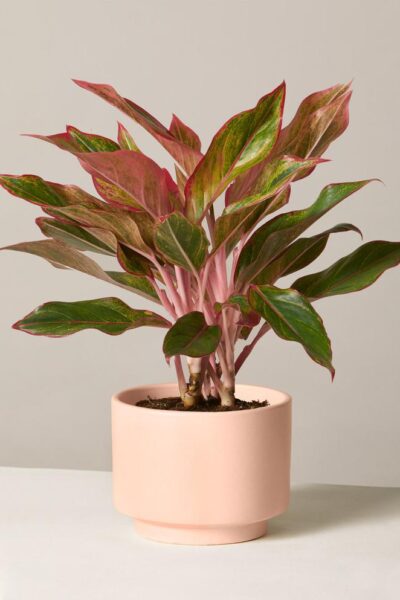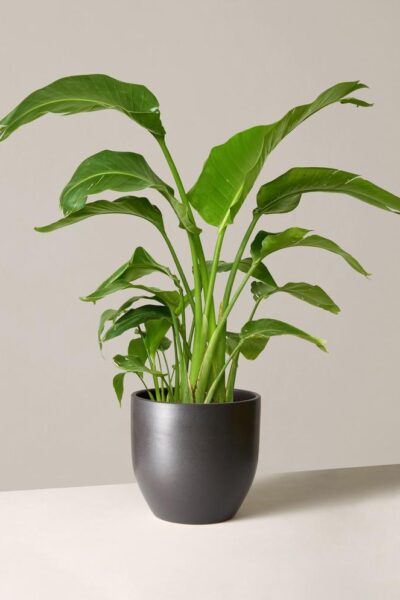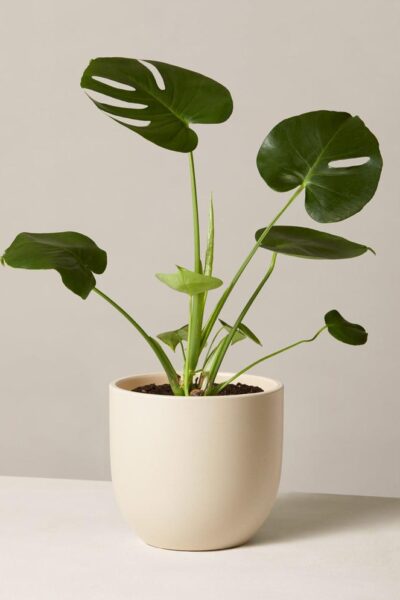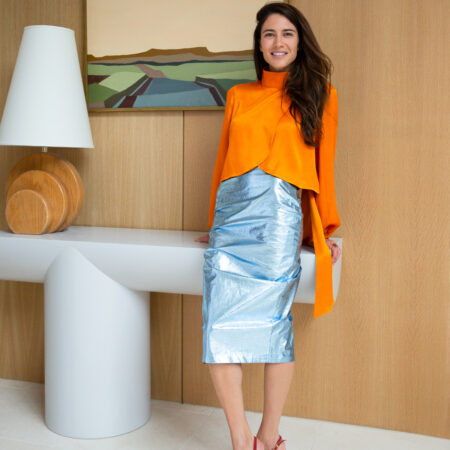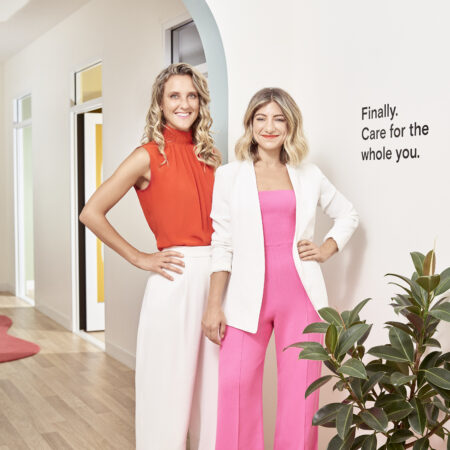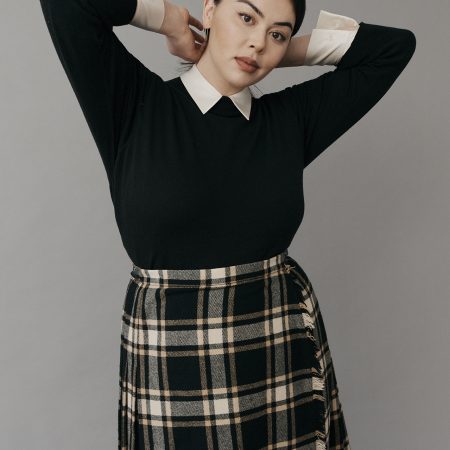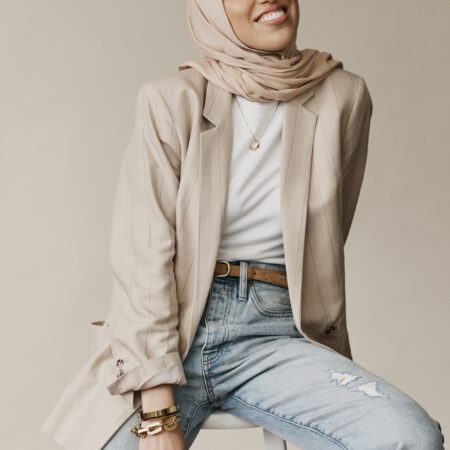When Eliza Blank moved from her rural Massachusetts hometown to New York City for college, she immediately felt the city’s lack of greenery and went in search of plants for her home. At the time, houseplants were hard to find. They were not available online, and gardening stores and nurseries didn’t cater to her demographic. “I wasn’t interested in growing roses in Connecticut,” Blank jokes. “I just wanted to have some house plants in a shitty apartment in New York City.”
By the time she graduated in 2007, her idea for The Sill, a direct-to-consumer houseplant company, had sprouted, only Blank had no idea how to execute it. After college, she worked in brand strategy at beauty brand Living Proof, where she learned the costs and considerations of starting a business. It was also there that she realized that raising capital too early can be detrimental. “I was a little disillusioned with the venture capital route of raising a ton of money, spending a ton of money, making expensive mistakes, and having to flip flop between the goal line of growth at all costs versus profitability,” she says. Blank knew that when it came to launching The Sill, she would bootstrap for as long as she could. She wanted to learn about her consumer first, to find product-market fit by selling her product. “When you’re subsidized by venture capital, it’s easy to cover up lack of product-market fit with marketing and advertising.”
I was disillusioned with the venture capital route of raising a ton of money, spending a ton of money, making expensive mistakes.
In February 2012, at 26, she quit her job at Living Proof to pursue The Sill full-time. Blank originally had a co-founder who she recruited from Living Proof and who was as excited about The Sill as she was. “That was my first point of validation,” Blank recalls. They put in some savings, just under $10,000 each, to get The Sill off the ground. Blank also launched a Kickstarter campaign in April 2012 with the goal of raising $12,000—“a very, very, very modest goal,” she says. Kickstarter was not only a platform for raising seed money but proof of what she was after: product-market fit. “I understood that if I couldn’t achieve the Kickstarter [goal], then I probably didn’t have a good idea for a business,” Blank admits. “You’re pre-selling the idea, you’re pre-selling the product.” She included contribution gifts in the campaign, from a hand-written thank you note to artisan-made planters. Friends, family, and colleagues all contributed, but so did strangers in the Kickstarter community who were curious about new products from budding entrepreneurs. (At the time, crowdsourcing was a relatively new and exciting concept.) “We actually got homepage placement on Kickstarter at one point during the month-long campaign,” Blank recalls, which helped bring in more funding. She raised $12,000 easily.
Their combined initial budget of approximately $32,000 lasted a long time. “That wasn’t our first month’s budget, it was our forever budget,” says Blank. “It was the only budget that existed.” The Kickstarter funds went almost entirely to product, with some towards photography. Blank was able to keep her initial costs low thanks to help from her brother, who was working at a creative agency at the time and loaned her both office space and a creative team to help design The Sill’s initial visual identity and website. She had some small-batch packaging made—bags, decorative tissue, a postcard, business cards—and planned to deliver the orders herself.
To source product, Blank paid out of her own pocket to attend the Tropical Plant Expo in Florida, an annual houseplant trade show. “I spent 12 hours just walking around the conference center, asking a million questions to try and figure out how the supply chain worked because I honestly had no idea,” she recalls. She took similar walks in New York City’s Flower District, standing on the corner of 28th and 6th, noting the distribution companies and intercepting flower trucks for information. She bought locally, sourcing plants from growers in the Northeast and planters from New York ceramicists. Most of her spending went towards the planters, which she had to buy in advance; she was able to buy the plants as orders came in. (Today, The Sill’s plants are still sourced domestically, and the planters are predominantly made in Southeast Asia by a female-owned company.)
Shop Our Favorite Plants from The Sill
The Sill officially launched in June 2012. A few weeks later, however, Blank realized that she and her co-founder had to part ways. “Our ambition for the business was a little different,” she recalls. “The fact that it was my idea that I was so very passionate about made it very difficult for us to co-helm the company.” They spent a few months figuring out how to dissolve the partnership, which racked up some costs for Blank, including legal fees, financial compensation, and a percentage of company ownership. “There was real value exchange in order to make the split as amiable as possible,” Blank reveals. She even put herself on a six-month payment plan to refund her co-founder’s initial investment. By October 2012, Blank was helming The Sill alone.
Later that fall, The Sill made its first hire, a marketing intern named Erin Marino. (Marino is now The Sill’s Director of Marketing.) With no marketing budget, they reached consumers via newsletter, Instagram—then a nascent marketing tool—and The Sill’s blog. They cold-emailed editors and gifted them plants. “Our biggest lever was media,” Blank recalls. Publications were intrigued by The Sill’s unique concept and business model, and the brand fit well within the Pinterest and Instagram design boom. Blank also partnered with brands like Refinery29 and DailyCandy, participating in their fashion markets as well as city flea markets, one of The Sill’s biggest expenses at the time. There was a participation fee and Blank bought a tent, tables, and signs. “We basically just broke even,” she recalls. Still, it was a learning experience, a way to promote The Sill, to meet its customer, and to understand what people liked.
From 2012 to 2014, revenue remained consistent but low. “Looking back, I don’t even know how I thought I should’ve kept going,” admits Blank. “I set some pretty arbitrary goals for myself, like, ‘if we can make X dollars, I’ll keep going.’ I hit those goals. They were incredibly low, but I was young enough that just the excitement of building something was all I needed.”
I was young enough that the excitement of building something was all I needed.
One of The Sill’s early lucky breaks was when the office manager of social networking app Vine asked Blank to outfit their office in plants. “I wasn’t even considering B2B sales,” says Blank. But office outfitting quickly became a lucrative gig for The Sill. When Vine was acquired by Twitter, The Sill planted out Twitter’s offices. Then WeWork—and its 75 buildings. Plant service clients came to The Sill entirely by word of mouth, and though B2B wasn’t part of Blank’s vision for the company, it doubled her cashflow, allowing her to bring in some early hires while slowly growing her direct-to-consumer business.
Aside from Marino, Blank hired a few contractors: Taskrabbits to help her deliver big orders, photographers who shot product, and someone to rotate, prune, and water the plants before they were delivered to new homes. Eventually, she hired a few more paid interns who helped with business strategy and pricing. Not yet taking a salary, Blank supported herself with consulting work and her personal savings. “I was living off peanut butter and jelly,” she remembers. “I really learned how to be frugal personally, which translated to the business and which is ultimately one of its best foundational values. I continue to be frugal both personally and professionally.”
In 2015, The Sill opened its first brick-and-mortar location in a 100-square-foot space in Chinatown in Manhattan. The company was growing—and outgrowing Blank’s brother’s office. “We weren’t thinking, ‘we’re going to open this beautiful plant store,’” she says. “We were just like, ‘we need space. Should that space be on the ground floor so that people can walk in off the street?’” A bodega around the corner from her brother’s office was up for rent. Blank had walked by every day. One day, she called the number in the window. “The location was not ideal by any means,” she admits, “but the price was just affordable for the size of business we were at that point.” It was about $3,000 a month on a three-year lease, and would also count as their office space. Her mom served as the guarantor on the lease.
Initially, Blank spent no money building up the store. “We threw a pizza party in the space and held a raffle to try and raise money [for the shop],” Blank recalls. She exchanged plant maintenance for a marble countertop. Blank and Marino ran retail out of a cash box. “It was very grassroots, very rudimentary,” says Blank. That same year, she took out a small business loan of $80,000 through TruFund, an organization whose mission is to stimulate economic development in underserved communities—including Chinatown. “I went to TruFund because I couldn’t get a small business loan anywhere else,” says Blank. “That was my first real sense that we were building something here. I was willing to invest in it, to take the risk.” The loan helped them finance the store and run their local operations, both for their plant-fit service and their DTC arm.
The Sill continued to grow. The company began to ship nationwide in 2015, and plant office outfitting kept its revenue high. In fact, the B2B business was so successful that it kept Blank too busy to build the original brand she envisioned during her Kickstarter days five years earlier. “That was part of my motivation for raising venture capital,” Blank says; to shed the service business and redirect The Sill toward consumers.
Blank was hesitant about raising VC, fearing that her company was too quirky for investor interest. “I again created arbitrary goals, like ‘I think I can get investors’ attention if I surpass $1 million in revenue on my own.’” Which she did in 2016 and again in 2017 before approaching investors. Though still uncertain, she took the leap. “I became very fearful that if I didn’t raise, someone else would see the opportunity and see what I was doing, then raise and blow by me,” she says. “I had worked way too hard to let that happen.”
Blank reached out to other founders to learn about the raising process and to discover which investors she should target. Luckily, investors were keen from the get-go. Andrew Mitchell from Brand Foundry Ventures already knew about The Sill and was ready to invest in Blank before she had even approached him. Still, it took “many, many months” for Blank to fill out the rest of her round. “A lot of it is based on storytelling conviction and as a solo female founder, talking about houseplants—before direct-to-consumer brands really became hot—was tough to find the right fit.” Brand Foundry Ventures led, and in October 2017, Blank raised $2.5 million in seed funding.
Raising while breastfeeding is way harder than raising while pregnant, just logistically.
With seed money in the bank, The Sill finally shed its service business and focused on acquiring customers. “Prior to raising, I hadn’t spent any meaningful amounts of money on paid customer acquisition,” she says. They finally had a marketing budget and were able to pay for ads, reach more people, and nail their product-market fit. Blank was also able to pay herself her first official salary: $60,000.
In 2018, Blank both finished paying off her TruFund loan and fundraised for her series A. The A round happened much more quickly than her seed. She now had proof of concept, proof that The Sill could acquire customers efficiently, and proof of scale. Courtney Favreau at Raine Ventures led the round. “What was compelling about Courtney,” says Blank, “is that she really understood the consumer. Not only is she a woman, but she is my target demographic just by age and education and income and geography.”
Blank was pregnant while raising her Series A, and was nervous to tell Favreau. “I mean, I was nervous to tell everybody I was pregnant,” she jokes. “Especially as a first-time mom, I didn’t know what to expect in terms of how it would impact my ability to lead, my desire to lead, and the balance of my life.” It didn’t occur to Blank that Favreau might be pregnant too. (They ended up giving birth a week apart.) When Blank raised an extension on her Series A a year later, she was postpartum. “Raising while breastfeeding is way harder than raising while pregnant, just logistically,” she recalls. It was also harder emotionally and physically. It was the first time she was separated from her baby; she pumped and saved milk on plane trips and asked investors if she could pump in their bathroom before meetings. She was dehydrated and constantly hungry. “It’s one thing if you’re visibly pregnant. People are more accommodating.” With breastfeeding, however, “people don’t know to accommodate you because you don’t appear to be in distress.” At one point, Favreau offered Blank her executive office as a pumping room, which helped to ease the experience.

The Sill raised a $5 million Series A, and Blank used that money for, she says, “maturing the business.” She expanded her leadership team, her operations team, her supply chain, and her marketing. She built out The Sill’s infrastructure, scaling their-brick-and-mortar channel with shops on the West Coast. She expanded The Sill’s plant education program and in-person events. One benefit of waiting so long to fundraise, it turned out, was that Blank knew exactly what to do with the money.
When COVID-19 hit earlier this year, The Sill, like every company, had to reckon with changes and loss. Blank and her team closed their five shops, canceled in-person events, transitioned to remote work, and reconfigured their supply chain and marketing towards their online channel as e-demand for houseplants rose. “With store closures, we had to go through a pretty rough patch that I would’ve never anticipated otherwise,” she says, attributing The Sill’s ability to recalibrate to its bootstrapping roots. “I think our DNA was already set up to problem solve and get through tough times. We are certainly not immune to all of the challenges that COVID has presented, but we had a solid foundation going into 2020 that has enabled us to survive this.” (The stores are now open for socially-distanced shopping and pick-up.)
Building the company from the ground up from nothing but personal savings was essential to defining The Sill’s values and success. “You are arguably more resilient, more scrappy, more resourceful,” Blank says, compared with a highly capitalized company. Those values keep her energized as CEO, and as The Sill—and its 75 employees—continues to grow. The customer, she says, is always at its root. “We’re building a business on the mantra that plants make people happy,” says Blank, “but what makes people happy will continue to evolve and change over the next 10 years. And we just have to be listening.”
Eliza Blanks Answers 5 Questions on Founding a Business:
1. What was your hesitancy in raising VC money early-on?
I understood that the downside of raising had to do with timing. If you raise too soon, you have the risk of not cracking product-market fit because you’re subsidized by venture capital. There’s a lot of ways to hide in your metrics that you’re acquiring customers, not because they love what you’re offering, but because you happen to throw an ad in front of the right person at the right time. I also didn’t think I’d be able to get it done. It was easier for me to see a path forward with venture post-Warby Parker’s success. I started almost the same time as Warby Parker and it hadn’t yet become apparent to me that you could even raise venture for a consumer brand in the way I was set up. I knew that I was going to have challenges. I was a solo founder selling what outsiders saw as a commodity. But I had a ton of ambition for the company. I wanted to be bigger than a hobby and bigger than a lifestyle brand.
2. How are you navigating the effects of COVID?
The fact that we were eight years old heading into 2020, I never felt like “Oh, we’re not going to make it through this.” I always knew no matter what, The Sill would survive. There’s a lot to be said about getting this far in and really understanding what it takes to get through the ups and downs of a business. I have more reason to believe that we’re going to make it all the way, whatever that means.
3. What do you like the most about being a Founder/CEO?
The Sill changes so dramatically year over year that I’m always energized, excited, and engaged in the business because I’ve grown alongside it. Every year it’s almost an entirely new business, whether it’s size, scale, or a problem to solve. It’s kept me far more engaged than I would be at any conventional role where your job’s not changing that much year-over-year.
4. What were the biggest lessons you learned working at a startup before launching The Sill?
I started thinking about the brand and the company when I was 21, but I was right out of school, I had no experience. I had a “business plan” but I couldn’t really understand how to get started and operationalize the idea. I was lucky enough to have the opportunity to spend four years working at a startup where I learned exactly that: How do you take an idea and operationalize it? How do you actually take it to market? What are the considerations? What do these things even cost? What does it cost to run a consumer survey? What does it cost to get the MVP up on your website?
5. What do you see for the future of The Sill?
I always set out to build the biggest possible company that I could. How we get there has evolved as customer tastes and behaviors have evolved, and we will continue to evolve alongside those. I can’t say with any certainty what the company will look like 10 years from now—I certainly dream about it—but what I do know is that we feel incredibly validated at this moment that plants make people happy, and we’re building a big business on that mantra. We’re taking it as it comes and making sure that we are staying close to the customer so that we can reach as many of them over and over and over again. I don’t think you can become a billion-dollar business by offering something a customer doesn’t want. There’s a quote that I’ve been using lately from Jerry Colonna, who runs the coaching organization Reboot. ‘The ultimate definition of resilience is to see that the world is always changing.” That really resonated with me, especially this year. It’s changed my opinion about how we think about the future, because the reality is, the world’s going to continue to change dramatically.
Dana Drori is a writer, actor, and model, based in New York.

